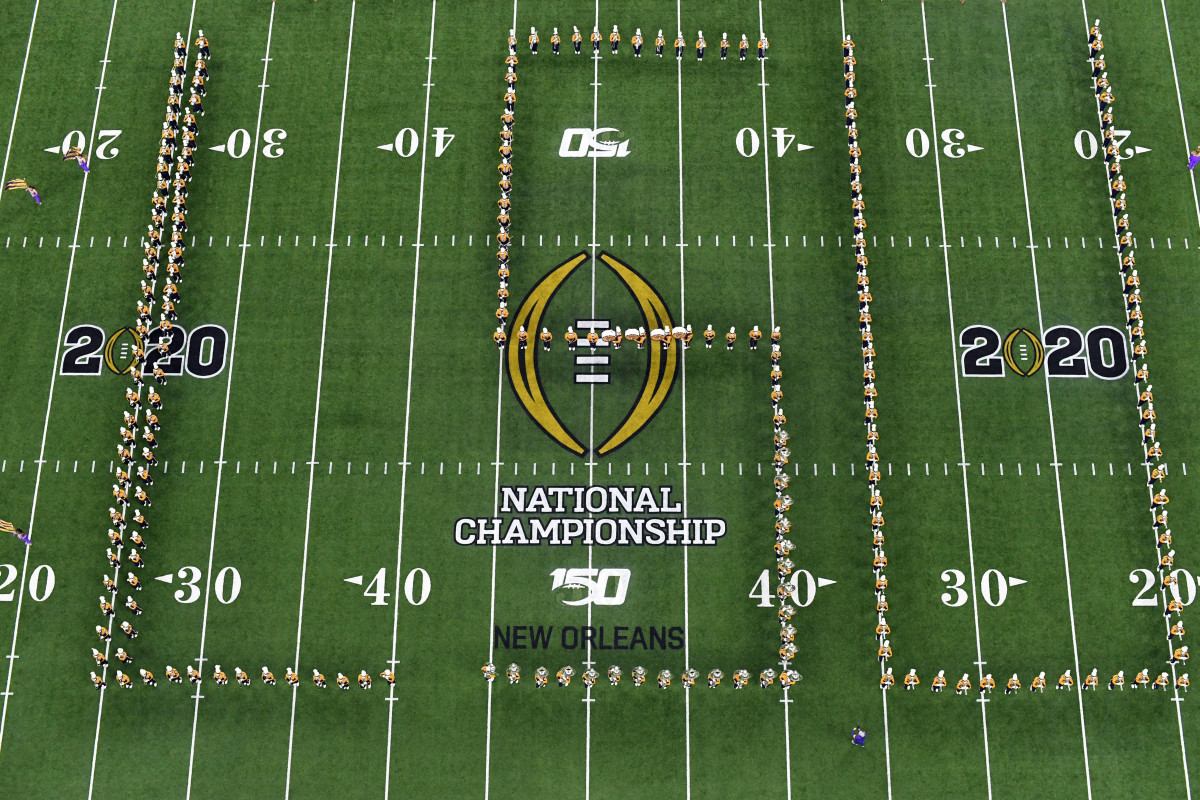Will The Show Still Go On For College Marching Bands During the COVID-19 Era?

CHAMPAIGN, Ill. -- Andy Christensen can vividly remember the emotional roller coaster he went through on March 12, the day the coronavirus ended sports for the foreseeable future.
Christensen, who will be a senior nuclear engineering major this fall at the University of Illinois and is one of the alto saxophone section leaders of the Illini marching band, knew he was on the precipice of what he had convinced himself would be an historic month of March. Twenty-four hours later, the 21-year-old never knew how right he’d be for the wrong reason.
“We were coming off this great win in the regular season finale against Iowa and we were going to head to Indianapolis for what we expected would be a decent, multiple-day run in the Big Ten tournament,” Christensen said. “What I’ll say too is as a college student, I remember watching and seeing band members play on television during the NCAA tournament. Illinois hadn’t been to the NCAA tournament during my entire time and I couldn’t wait for the moment to play in that environment.”

While he was preparing to leave for the event, Christensen had seen the media reports describing the COVID-19 postponements and cancellations throughout the day. When he got the news in that afternoon of the Big Ten tournament being cancelled, Christensen knew what was next.
“I remember going through a stage of different emotions that started with being really, really upset and then being really nervous for the future of everything and then being really sad for the seniors who I immediately knew wouldn’t be playing again,” Christensen said.
Illinois was days away from making its return to the NCAA tournament for the first time since 2013 and that meant seniors on the Illini marching band had never experienced postseason play.
“I know the athletes are what you think of first and I believe that’s what is supposed to happen but I also can’t imagine the initial pain by band seniors who knew they’d performed for the last time,” Christensen said.
What Has Already Changed With College Marching Bands Due to COVID-19?
One of the biggest differences for Illini Marching Band director Barry L. Houser started with the selection of new and freshman members. Social distancing protocols and stay-at-home orders around the nation of the spring and early summer months forced evaluations to take place via taped productions and live Zoom performances.
Across 20 different states in front yards, garages and apartment living rooms, teenagers were playing their instruments into a video camera or computer camera for the opportunity to be one of around 375 members of the marching band at the University of Illinois. This development also meant the neighbors of these tryout participants were hearing the Illinois fight song at full volume by drummers, clarinet players, saxophonists and trumpeters.
“I’d like to think the Illinois residents at least may have been able to recognize what the heck songs these tryout candidates were playing,” Houser said with a laugh. “But I’m sure a lot of them were trying to figure out what was going on.”
Nearly five months after all sports immediately stopped because of a generationally unique virus and worldwide health epidemic, college marching bands are still trying to figure out if they can safely perform. In a lot of ways, the search by university athletics personnel and conference officials across the country for a safe compromise leaves the marching band situation not much different than any other fall season sporting activity, such as Power 5 football.
“In looking at all the data, we’ve got to start making assessments working with our health officials, medical professionals on something that is safe." —Barry L. Houser, Fighting Illini Marching Band director and committee chairman for the College Band Directors National Association
Not only the director of the Fighting Illini Marching Band since 2011, Houser also serves as the athletic bands committee chairman for the College Band Directors National Association. It’s that national position that forces the Indiana native to be informed on daily decisions being made across the country that affect the way college sports and band performances could look in the near future.
“In looking at all the data, we’ve got to start making assessments working with our health officials, medical professionals on something that is safe,” Houser said. “I’ll be honest with you. Our campus doesn’t know the answers to that because they’re not experts on musical instruments. So, we have to be informing them on what we do know and are currently looking into.”
Is It Safe To Play A Wind Instrument During A COVID-19 Epidemic?
A scientific study with multiple tentacles in the music industry started at the University of Colorado and the University of Maryland has begun to produce preliminary results. Preliminary recommendations from the Performing Arts Aerosol Study, released by a pair of lead researchers (Shelly Miller, a mechanical engineering professor at the University of Colorado and Jelena Srebric, associate dean of research in the engineering department at the University of Maryland) provide guidance to educators as to how they might best position their musicians during a worldwide health pandemic that is unprecedented for so many different reasons. The initial results, which were released online without peer review, showed for the first time that playing a musical instrument can produce droplets that can carry the COVID-19 virus. The study showed these “aerosols” produced from the wind and spit needed to play the instrument—obviously without the proper face coverings recommended by medical officials—can stay airborne for long periods of time and different instruments can produce different amounts of droplets. An example from the study found the trumpet and clarinet, which run straighter from the mouthpiece to the instrument opening, had higher concentrations of the droplets that could lead to a spread of COVID-19.
“Once you know what the instruments are releasing or the musicians, you can put that into the simulation environments and then test what is happening in the space without having to physically be there,” Srebric told The Tampa Bay Times.
What Are The Various Plans For College Marching Bands This Fall?
With these initial studies showing preliminary data that suggests droplets can possibly accumulate in large amounts by playing a wind-based instrument and social distancing being viewed as difficult to impossible, athletic conferences have begun to restrict marching band performances for events in the near future. Multiple reports say the Atlantic Coast Conference, the American Athletic Conference and Big 12 Conference have already restricted travel and performances of marching bands, dance teams and cheerleaders.
University of Illinois officials, specifically university chancellor Robert Jones and athletics director Josh Whitman, held on July 16 what they called a “public presentation” regarding fall sports on campus.
“Even if we’re playing in front of no fans, it’ll be different,” Illinois junior offensive guard Kendrick Green said. “I know, as a player, that I draw adrenaline and emotion from the crowd and the passion the atmosphere of a college football game brings from the band, the crowd and everything that goes with it.”
Despite his obvious optimism on being able to start sporting seasons in this fall semester, Whitman said during the 50-minute presentation that he was unable to confirm any decisions being made on the U of I campus in regards to the marching band.
“Our plan is to engage in all of our fall sports. Our plan is all of those sports will compete this fall. All of these decisions that have been made…are being made with an eye toward putting us in the best position to have sports,” Whitman said in July. “With the understanding that if circumstances dictate, we certainly won’t hesitate to pull the car over if you will.”
According to Cowbell Corner/Sports Illustrated, Mississippi State and the Southeastern Conference have also not officially decided any plan of action for the school’s marching band.
"Those decisions have not been made," Mississippi State associate director of bands Craig Aarhus said. "And I don’t think it’s because they’re not wanting to tell us anything. I just think there are so many major decisions that they’re having to make about the environment, about the game day and about everything. We’re part of that, but you know they have a lot more important decisions they have to make before they can really address us. We’re not sure if that’s going to come from the SEC office and it’s going to be a uniform policy throughout the conference, or if that’s going to be something that individual schools are going to be allowed to manage a little bit more depending on their situation."

Houser, who has directed marching band performances in his career for the Macy’s Thanksgiving Day Parade, The NBC Today Show, the Indianapolis 500 Parade, the Target Thanksgiving Day Parade, the Outback Bowl Parade and Halftime Show, and the Washington D.C. National Memorial Parade, has admitted this COVID-19 pandemic has changed plans and practices for marching bands at both the college and high school level across the country.
Houser still remains hopeful that a small Illini pep band could be used at Memorial Stadium for home football games this fall, due to the stage four reopening plan by Illinois Governor J.B. Pritzker that allows for “outdoor spectator sports can resume with no more than 20 percent of seating capacity”. However, even if a marching band is not allowed inside a stadium, the unknown factors regarding COVID-19 have forced Houser to find unique, creative ideas.
“Let’s say we can only do 50 people (in the band), we’re not going to be able to do anything on the field but we can be in the stands still supporting our team, provide school spirit and perform so that’s something our students are still hopeful and excited about,” Houser said. “At that point hypothetically, we’ll have to break up our 375-member group into groups of 50. So, maybe in pre-game we can send out those several smaller 50-member groups around the stadium and campus to provide Illini cheer. I don’t want to say it’s a better situation than we’ve had in the past because it’s not. But we’re trying to make lemonade out of these lemons we’re being handed.”
Christensen was in the saxophone section of the Illini Marching Band during Illinois’ 24-23 upset home win over then-No. 6 Wisconsin last year, where he admitted to “nearly passing out in excitement” following the game-winning field goal as time expired. Christensen said he has faith in Houser being able to find ways to ensure the Illinois men’s basketball regular season finale win over Iowa at State Farm Center on March 8, 2020 is not his class’ final band performance.
“My mom says I came out of the womb bleeding Illinois orange and blue,” Christensen said. “I’m so appreciative when I hear from Illini players and fans that I’m even just a small part in their experience on a fall Saturday at Memorial Stadium because then I feel I’ve done my job.”
